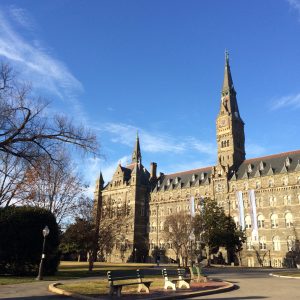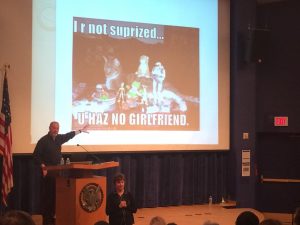 Heading to another conference (AAAL in Toronto) is a strange time to be blogging about a conference from last weekend, but the Georgetown Roundtable on Languages and Linguistics was too good not to want to revisit what I learned and somehow record it, pay it forward to later times, places, and conversations. There were so many ideas being tossed back and forth, needing so much more work for me to better understand and apply to my own contexts, that I thought the term “borrow-aways” might be more suitable than “take-aways” (does it work?)
Heading to another conference (AAAL in Toronto) is a strange time to be blogging about a conference from last weekend, but the Georgetown Roundtable on Languages and Linguistics was too good not to want to revisit what I learned and somehow record it, pay it forward to later times, places, and conversations. There were so many ideas being tossed back and forth, needing so much more work for me to better understand and apply to my own contexts, that I thought the term “borrow-aways” might be more suitable than “take-aways” (does it work?)
My first motivation for going was to listen to a panel I had discovered on the program several weeks before, entitled “Linguistic Landscape as a Pedagogical Space for Second Language Learning” (link opens PDF; scroll to bottom left). This was so salient to a few projects on the topic I’ve been working on—planning sessions on pedagogical applications at the upcoming Linguistic Landscape 7 workshop in Berkeley, and engaging in discussions with faculty at Columbia University and here at Yale on language teaching in the linguistic landscape—that I was delighted to find out that it was none other than María Eugenia Lozano, Lee Abraham, and Juan Pablo Jiménez-Caicedo of Columbia’s Department of Spanish & Iberian Languages convening the panel. And then, even happier to be asked to serve as a discussant for this panel.
Topics raised at their linguistic landscape panel echoed the concern of the conference’s theme “Diversity and Superdiversity” (where “superdiversity” was glossed as “the diversification of diversity” typifying populations in today’s cities and world). But the interest was of course in its pedagogical applications: how can language learners develop communicative and symbolic competencies through greater awareness of the contextual, cultural, multimodal, and political usage of language in place? Thee presenters’ answers were based on years of work integrating out-of-class and city-based language learning projects across the Spanish language curriculum, with learners taking photographs outside and debating and presenting on their significance in first-year courses, conducting community-based interviews and social-media composition projects that draw from their further experiences in the LL during the second year, and then participating in ethnographically-oriented projects focused on dance and art in the city in the third year of courses.
Response from the audience demonstrated interest from the vantage point of fellow practitioners with questions that were debated but remain open for discussion: How can you integrate LL-based projects into the curriculum? How can and should they be assessed? How can a linguistic landscape approach be designed for languages less visible in U.S. cities than Spanish? How can you, and do you, meaningfully follow up with students months and years after their community-based learning experiences, to gauge the impact of these activities over the long term?
Beyond this panel, GURT was a great opportunity to get inspired (and provoked) by recent developments in socio- and applied linguistics research. Among the tidbits that remain with me are:
- Elizabeth Miller (UNC-Charlotte)’s problematization of ideology through a performative/poststructural approach that shows how people don’t just contest ideologically problematic (gendered, racial, linguistic, etc.) categories that are assigned to them by others, but sometimes assume these very identities in order to open up opportunities for dialog and reinterpretation around them. I have a soft spot for Judith Butler, whose ideas Miller drew heavily from, and her thoughts about “recognizability” and the transformational power of the performative seem more relevant now than ever.
- Nelson Flores (UPenn)’s questioning of normative assumptions about “good” and “bad” code-switchers and underlying theories of code-switching (or in others’ words, the merging, blending, hybridization of repertoires). He took issue with Blommaert and others’ characterization of speakers of ‘parts’ of many languages in superdiverse conditions—the term Blommaert introduced was “truncated repertoires”—saying that the term “truncated” takes for granted that “languages” are complete entities from the get-go, and this very idea has been debated now for quite some time. In his view (and mine), “translanguaging,” itself a term that people have used to try to get away from the notion of “switching” between static linguistic “codes,’ still seems to assume linguistic ‘borders’ that must be crossed, although, he mentioned others like Ofelia Garcia see the “trans” of translanguaging as about “transformation” and thus not being bound to complete linguistic systems that everyday speakers and learners of languages can never hope to acquire completely.
- Daniel Ginsberg (Georgetown)’s micro-analysis of emails he exchanged with school district representatives as he negotiated (successfully, in parts, and less so, in others) the terms under which he could conduct ethnographic research in classroom settings. This was fascinating to me as his efforts to position himself as an “ethnographer” in the face of research protocols and expectations that see research overwhelmingly as comprised of isolated or one-time, quantitative measurements of status or ability (as opposed to the sustained, observational and interpretive techniques used in ethnography) required him to find and appeal to institutions of authority in order to try to explain just what qualitative research was, just as the district rep frequently invoked policies to substantiate her position. A key question in analyzing the discourse of the back-and-forth threads of emails was about agency—not just how one can make one’s case while facing significant institutional barriers, but what precisely are the discursive indicators of ‘openings’ in dialog and moments of intersubjectivity between interlocutors that might develop into social change? (Anthony Giddens, Fred Erickson among those cited here)
This is just a sampling of the sessions that piqued my curiosity; keynotes by Norma Mendoza-Denton, Elana Shohamy, Jan Blommaert, and others were provocative as well. Together, they helped frame questions about language, power, and modes of representation that are now carrying me onto this full flight from LaGuardia to Toronto. So now it’s time to switch off the wifi and say, “Hello, AAAL…”
Cross-posted from Multilingual Commons
